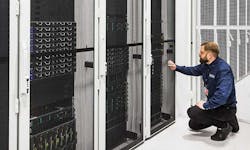As the rise of cloud computing has boosted the fortunes of the hyperscale platforms, other service providers have sought to sharpen their focus on market niches. One example is Iceland-based data center specialist Verne Global, which is building its business around high-performance computing (HPC).
Today Verne Global introduced hpcDIRECT, a new HPC-as-a-service platform offering cloud hosting tailored for resource-intensive technical workloads. The new service will run in Verne Global’s data center in Keflavik, Iceland, but can be managed remotely by HPC users around the world. Verne Global is optimizing the hardware and network for hpcDIRECT based on input from its growing base of technical computing clients.
“Building hpcDIRECT was a direct response to overwhelming demand from our customers and tightly correlated with the market’s desire to move from a CapEx to an OpEx model for high performance computing,” said Dominic Ward, Managing Director at Verne Global. “hpcDIRECT has been designed and built from the outset by HPC specialists for HPC applications.”
hpcDIRECT runs as a “bare metal” service – effectively a single-tenant server using a hypervisor that allows direct access to hardware resources, rather than running inside an operating system. It also offers high-speed connectivity between nodes by using a high-speed Infiniband interconnect.
Focusing on Three HPC Verticals
Verne Global isn’t the first provider in the HPC sector to offer an “as-a-service” offering for cloud architectures. But the company believes it can gain traction in HPC by building upon its relationships with users in three verticals:
- Manufacturing, especially the automotive sector, where BMW is a marquee customer. Automotive HPC use cases include crash test simulations, and testing aerodynamics and design usings wind tunnel simulations.
- Life Sciences, including researchers focused on genomics who are test-driving general purpose GPUs.
- Financial Services, including risk management firms like RMS that leverage financial data feeds Verne Global offers via financial specialists like Colt and Rabianz.
One early customers is doing weather analysis via the hpcDIRECT environment, which is managed through Verne Global’s CloudPoint customer portal
“We’re building out a dedicated, secure environment for hpcDIRECT within our Power Direct offering,” said Tate Cantrell, the CTO of Verne Global. “Physically, it’s secure cabinets and a handoff for customers via an encrypted connection to a private network.”
Leveraging Iceland’s Renewable Power
Verne Global’s data center was built in a former NATO command center, takes advantage of Iceland’s vast supply of renewable energy (hydroelectric and geothermal), along with a cool climate that allows the year-round use of outside air for free cooling for the entire year.
A key selling point for Verne Global is Iceland’s supply of hydro power, generated by dams like this one at the Ljósafossstöð hydroelectric plant on the River Sog. (Photo: Rich Miller)
“We see (hpcDIRECT) as a natural transition for what we’ve accomplished as a business,” said Cantrell. “We decided first to focus on energy. We tapped into the natural resources in Iceland and developed the physical data center on top of the NATO base. We have customers from as far away as China – literally halfway around the world – operating a data center in Iceland as if it were at their own site.”
Verne Global has operated as a wholesale data center provider, selling turn-key space in data suites and modules where customers can deploy their IT gear. With hpcDIRECT, Verne Global is moving up the value chain into the “as a service” cloud territory. Cantrell said offering HPC-as-a-service makes Verne Global’s data center infrastructure available to a wider group of remote clients.
“In some cases, customers don’t want to go to the trouble of buying servers and putting them on a ship or plane and shipping it to us,” said Cantrell. “We wanted to let these customers operate a private cloud in our environment. The control plane for our cloud is built to be robust and purpose built for our key industries and customers.
hpcDIRECT is available with no upfront charges and can be provisioned rapidly to the size and configuration needed. hpcDIRECT clusters are built using the latest architectures available including Intel’s Xeon (Skylake) processors, and fast intercore connectivity using Mellanox Infiniband and Ethernet networks, with storage and memory options to suit each customer’s needs.
Innovation, Computing Power Drive HPC Growth
“We’ve moved to the point where we’re providing higher value-add services,” said Ward. “One thing that’s consistent is that we’ve see rapid growth of HPC, and we absolutely see this continuing. It’s really driven by the need to focus on what these companies do best. There is an ability to move from a capital expenditure model to an operating as a service model.This lets our customers manage their needs on a much more flexible basis. They can augment their capabilities as they need, when they need it and when they want it. This is a really big shift.”
“One of the reasons we see increased demand is that the next round of innovation is occurring within applications that reside within high performance computing,” said Cantrell. “It’s all about computation and resources. We’re making this streamlined to provide people with access to these resources.”
Cantrell says Verne Global has positioned its business to capitalize on this trend.
“We made a decision to shift a lot of energy to this,” said Cantrell. “We are restructuring the business to support this from the ground up. We openly have refocused elements of the business to support this level of service.
One of the reasons we see increased demand is that the next round of innovation is occurring within applications that reside within high performance computing. It’s all about computation and resources. We’re making this streamlined to provide people with access to these resources.”






